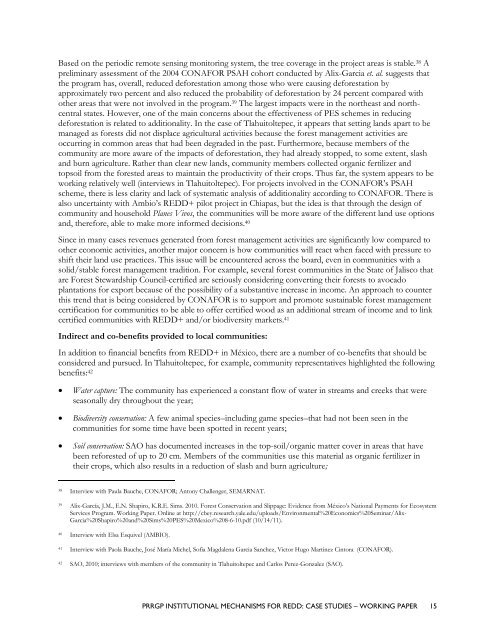Institutional Mechanisms for REDD+ - Case Studies Working Paper
Institutional Mechanisms for REDD+ - Case Studies Working Paper
Institutional Mechanisms for REDD+ - Case Studies Working Paper
You also want an ePaper? Increase the reach of your titles
YUMPU automatically turns print PDFs into web optimized ePapers that Google loves.
Based on the periodic remote sensing monitoring system, the tree coverage in the project areas is stable. 38 A<br />
preliminary assessment of the 2004 CONAFOR PSAH cohort conducted by Alix-Garcia et. al. suggests that<br />
the program has, overall, reduced de<strong>for</strong>estation among those who were causing de<strong>for</strong>estation by<br />
approximately two percent and also reduced the probability of de<strong>for</strong>estation by 24 percent compared with<br />
other areas that were not involved in the program. 39 The largest impacts were in the northeast and northcentral<br />
states. However, one of the main concerns about the effectiveness of PES schemes in reducing<br />
de<strong>for</strong>estation is related to additionality. In the case of Tlahuitoltepec, it appears that setting lands apart to be<br />
managed as <strong>for</strong>ests did not displace agricultural activities because the <strong>for</strong>est management activities are<br />
occurring in common areas that had been degraded in the past. Furthermore, because members of the<br />
community are more aware of the impacts of de<strong>for</strong>estation, they had already stopped, to some extent, slash<br />
and burn agriculture. Rather than clear new lands, community members collected organic fertilizer and<br />
topsoil from the <strong>for</strong>ested areas to maintain the productivity of their crops. Thus far, the system appears to be<br />
working relatively well (interviews in Tlahuitoltepec). For projects involved in the CONAFOR‘s PSAH<br />
scheme, there is less clarity and lack of systematic analysis of additionality according to CONAFOR. There is<br />
also uncertainty with Ambio‘s <strong>REDD+</strong> pilot project in Chiapas, but the idea is that through the design of<br />
community and household Planes Vivos, the communities will be more aware of the different land use options<br />
and, there<strong>for</strong>e, able to make more in<strong>for</strong>med decisions. 40<br />
Since in many cases revenues generated from <strong>for</strong>est management activities are significantly low compared to<br />
other economic activities, another major concern is how communities will react when faced with pressure to<br />
shift their land use practices. This issue will be encountered across the board, even in communities with a<br />
solid/stable <strong>for</strong>est management tradition. For example, several <strong>for</strong>est communities in the State of Jalisco that<br />
are Forest Stewardship Council-certified are seriously considering converting their <strong>for</strong>ests to avocado<br />
plantations <strong>for</strong> export because of the possibility of a substantive increase in income. An approach to counter<br />
this trend that is being considered by CONAFOR is to support and promote sustainable <strong>for</strong>est management<br />
certification <strong>for</strong> communities to be able to offer certified wood as an additional stream of income and to link<br />
certified communities with <strong>REDD+</strong> and/or biodiversity markets. 41<br />
Indirect and co-benefits provided to local communities:<br />
In addition to financial benefits from <strong>REDD+</strong> in México, there are a number of co-benefits that should be<br />
considered and pursued. In Tlahuitoltepec, <strong>for</strong> example, community representatives highlighted the following<br />
benefits: 42<br />
� Water capture: The community has experienced a constant flow of water in streams and creeks that were<br />
seasonally dry throughout the year;<br />
� Biodiversity conservation: A few animal species–including game species–that had not been seen in the<br />
communities <strong>for</strong> some time have been spotted in recent years;<br />
� Soil conservation: SAO has documented increases in the top-soil/organic matter cover in areas that have<br />
been re<strong>for</strong>ested of up to 20 cm. Members of the communities use this material as organic fertilizer in<br />
their crops, which also results in a reduction of slash and burn agriculture;<br />
38 Interview with Paula Bauche, CONAFOR; Antony Challenger, SEMARNAT.<br />
39 Alix-García, J.M., E.N. Shapiro, K.R.E. Sims. 2010. Forest Conservation and Slippage: Evidence from México‘s National Payments <strong>for</strong> Ecosystem<br />
Services Program. <strong>Working</strong> <strong>Paper</strong>. Online at http://cbey.research.yale.edu/uploads/Environmental%20Economics%20Seminar/Alix-<br />
Garcia%20Shapiro%20and%20Sims%20PES%20Mexico%208-6-10.pdf (10/14/11).<br />
40 Interview with Elsa Esquivel (AMBIO).<br />
41 Interview with Paola Bauche, José María Michel, Sofia Magdalena Garcia Sanchez, Victor Hugo Martinez Cintora (CONAFOR).<br />
42 SAO, 2010; interviews with members of the community in Tlahuitoltepec and Carlos Perez-Gonzalez (SAO).<br />
PRRGP INSTITUTIONAL MECHANISMS FOR REDD: CASE STUDIES – WORKING PAPER 15

















